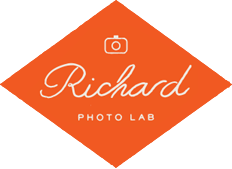It’s a question every photographer, both film and digital, has asked themselves: do I need a JPEG or a TIFF?
Are you going to use the image online? Will you be using it for photo printing? Each file format has its place among your favorite photos, so join Richard Photo Lab as we explore their special characteristics and when you should use each one!
WHAT IS A JPEG?
A JPEG (or Joint Photographic Experts Group) is a raster image file format, meaning that it’s composed of a grid of pixels.
JPEGs use a super-smart compression system that deletes data in a file to make the file size smaller. Then, when the JPEG is opened again, the program opening it will use the information remaining in the file to “guesstimate” a reconstruction of the missing data. You can select different levels of compression, and every time the image is edited and saved it will be compressed to some degree. This compression is heavier in color than clarity.
 Above image courtesy of Steven Larson
Above image courtesy of Steven Larson
WHAT IS A TIFF?
A TIFF (or Tagged Image File Format) is also a raster image file format, in that it’s composed of a grid of pixels.
TIFFs are typically uncompressed files or use lossless compression. This results in very high quality images and, subsequently, very large file sizes. Note: a JPEG that is converted into a TIFF will not have a lossless image quality. Any existing file degradation will be carried into the TIFF, it just won’t continue to lose data as you edit and save.
WHAT ABOUT JPEG 2000?
Aww, poor JPEG 2000. It’s actually a superior version of the JPEG because it compresses with less degradation to the image while still producing a small file size. But this file format got stuck in a vicious cycle after it was released. Tech companies and camera manufacturers didn’t want to update their products to be compatible with the JPEG 2000 format until it was widely used, but consumers didn’t want to use it until the format was widely supported.
SO WHICH ONE IS BETTER?
Whoa now, slow your roll… After reading the above, you’re probably thinking “Why would I ever NOT want a TIFF?” But there’s more to the story than that. It all depends on the type of photographer you are, what you are doing with the files, and what your needs are!
WHAT IF I’M A DIGITAL PHOTOGRAPHER?
When you are shooting, you can typically choose to shoot your digital photos as RAW files or JPEGS. RAW files have all of the unprocessed data from your camera, and they have to be converted to another file format (like JPEG or TIFF) on your computer to use.
Shoot RAW files if you aren’t confident in your exposure & white balance and/or you know you will be doing heavy editing. Your in-camera settings can actually be readjusted after shooting within the RAW file format (see below).
Shooting directly to JPEG will give you more shots on your memory card. They’ll save you time both during shooting and after by eliminating the need to convert large files for viewing. But you won’t get the same latitude for editing in post-production, or the same range of colors for digital display.
 Above image courtesy of Steven Larson
Above image courtesy of Steven Larson
If you decide to shoot RAW, you will have to convert your files to use them. But you still must decide if you want to store the RAW files long term or only keep JPEGs or TIFFs.
Again, if you are planning on manipulating your images in the future, RAW or TIFF files are best. One of the cool things about TIFF files is that lossless compression allows them to have all the same data as a RAW file but still be smaller (saving you precious storage space). It’s kinda like a math equation: if RAW = 2+2+2+2+2+3, then TIFF = 5(2)+3. Same info, different way of storing it.
But if speed and storage space are your primary concerns, store your final images as high quality JPEGs! We converted files from RAW to both high quality JPEG and TIFF, and typically the TIFFs were six or seven times the size of the JPEGs.
WHAT IF I’M A FILM PHOTOGRAPHER?
JPEGs and TIFFs work a bit differently with film... After all, the information for the images you captured wasn’t stored on a sensor, it was saved in your film negative!
There is no such thing as a RAW file when it comes to film scans because, unlike digital cameras, there is no existing software that can take the raw data from a scanner and turn it into a usable RAW file format.
But first thing’s first: the Frontier scanner can’t even produce a true TIFF, so don’t bother asking.
If you are ordering Frontier scans in TIFF format from a lab, they are being converted from the original scan file to a TIFF - which you can easily do at home.
What about the Noritsu scanner? Check out our comparison below of a JPEG and TIFF of the same negatives scanned on the Noritsu; there’s no visual difference!
But, the JPEG scans have much more manageable file sizes. A large Noritsu scan in JPEG format is only 12-15 megabytes, while a large Noritsu scan in TIFF format is more than 50 megabytes. If you have 500 shots in one order, that’s a difference of 17,500 megabytes!
Download the original scan files here!


 Above image courtesy of Albany Katz
Above image courtesy of Albany Katz
If you need to do some light editing on your scans, save a master copy of your image in TIFF format to maintain image quality as you go through the post-production process.
WHAT IF I’M PRINTING MY IMAGES?
TIFFs have a history rooted in desktop publishing and commercial printing. But while the difference in image quality between a JPEG and a TIFF greatly affects the manipulability of the image, it doesn’t really translate directly to printing. Even professional quality print service machines can’t reproduce all that extra image data that TIFFs contain. Our eyes can’t even perceive the full color intensity a TIFF can display!
That’s why high quality JPEGs can produce high quality photo prints of your favorite memories that are just as good as those from a TIFF.
Plus, JPEGs are one of the most “readable” file formats. They’re compatible with the many different print ordering softwares/apps/websites available nowadays (and all technologies for that matter, from your Instagram posts to your online portfolio), but TIFFs are not.

